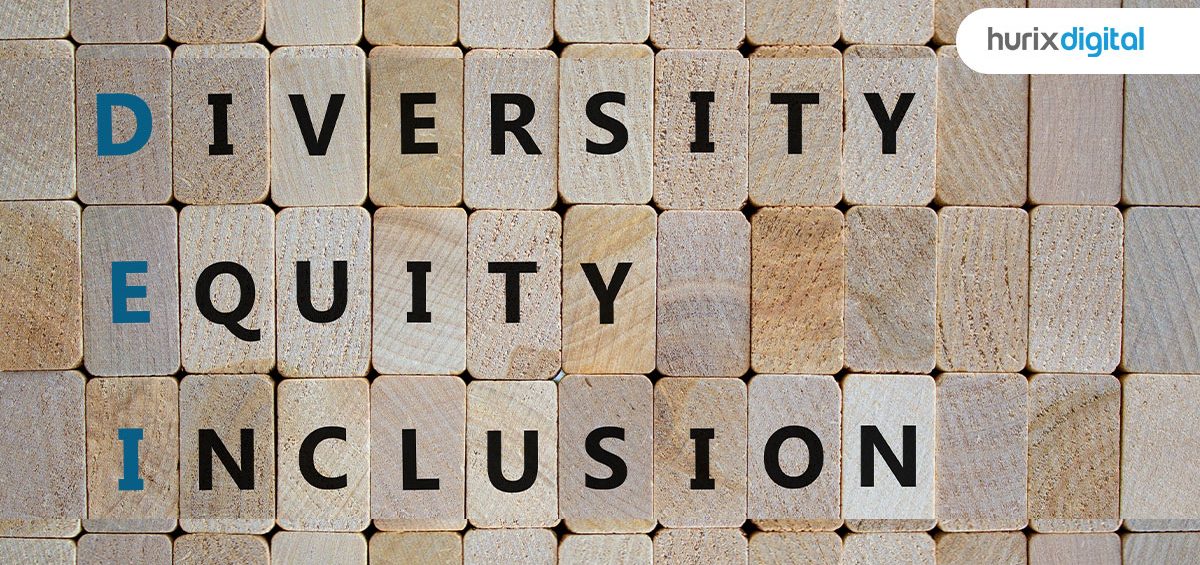Summary
Dive into the critical conversation surrounding Diversity, Equity, and Inclusion (DEI) in K-12 Education with our insightful blog. Discover the profound impact of DEI initiatives on students, educators, and the entire educational landscape. Explore strategies, challenges, and the transformative potential of fostering inclusive learning environments.
The prevalence of Diversity, Equity, and Inclusion (DEI) in K-12 education can be seen just like in every industry. In K-12 education, it plays a crucial role and has become the need of the hour.
In the recent webinar organized by the digital platform, Hurix Digital explored wide-ranging ideas and concepts pertaining to DEI in K-12 education. The main panelist in the webinar was Kristy Lilas – Vice President of Diversity, Inclusion, and Belonging at GoDaddy and Tracy Cugini – Editorial Director, Education at Hurix Digital. Hosted by Tejas Pitkar – Sr. Manager, Outbound Marketing at Hurix Digital, the program covered an hour-long discussion on the different paraphernalia of digital education.
Hurix Digital, as a strong digital learning platform deeply understands the various ways of providing effective learning to its students. It religiously believes in DEI which stands for Diversity, Equity and Inclusion. As a fact, education has no age. Learning can be done at any stage in our lives. School children can take advanced courses digitally whereas office-goers can pick up unlearned skills while they earn money. Such is the motive of Hurix Digital.
Table of Contents:
- Three Key Topics for the Discussion on DEI in K-12 Education
- Future Trends in DEI for the K-12 Education Industry
- Conclusion
Three Key Topics for the Discussion on DEI in K-12 Education
- Importance and benefits of having DEI in K-12 educational content
- Designing DEI in schools training and awareness programs for your school
- Future trends in DEI for the K-12 education industry
The webinar was attended by people like K-12 educators, EdTech Providers, K-12 school administrators and Learning curriculum designers. It was for them to comprehend the vision of the DEI mode of education and how they could add more value to it.
Diversity in education has been neglected for the longest. But a diverse group of students are likely to bring variety to the process of learning. DEI breaks through the different barriers in learning like race, ethnicity, gender, sexual orientation, religion, socio-economic status, differently abled bodies, and various learning styles.
It is important to comprehend exactly what you want to teach your learners. One has to focus on the definite areas of lessons that will help them to improve their performance. The organization needs to plan the objectives that will help them in achieving their effective learning. A keen understanding of the impact of the objectives, acknowledging the loopholes in them and bridging the gaps will set the process to the right path.
Also, one must consider the role of creating the right action plan. Collecting and designing the materials that will help them to define their agenda and enrich the knowledge-base for the learners. The organization has to implement the program. In this stage, it must notice the response and attentiveness of the learners to the education program.
Although the scenario of DEI in education has finally kicked in the education industry, it is not going to remain stagnant. Yes, this is not it and it is likely to change in the future.
The organization must evaluate the process, especially how well students understand the lessons and whether they are implementing it in their performance. This will help the organization to understand their program’s strengths and weaknesses.
Future Trends in DEI for the K-12 Education Industry
- An Immersive Learning Experience
- There will be more personalized learning modules as the learning pace is different for everyone.
- Classrooms will not be bound to four walls, they could be created at any place at any time.
- Education will embody itself into gamification which will attract learners to learn more.
- Video-based interactive learning will help students evaluate their lessons frequently.
DEI in Education has a long way to go. In fact, it has just begun, doing wonders in the education industry.
Also Read – How to Infuse Diversity and Inclusivity into Your Curriculum Design
Conclusion
In conclusion, the impact of Diversity, Equity, and Inclusion (DEI) in K-12 education is profound and far-reaching. By fostering a diverse and inclusive learning environment, schools can promote academic success, and social cohesion, and prepare students for a multicultural world. Embracing DEI principles empowers students to thrive, regardless of background, and cultivates empathy, respect, and understanding. As we continue to prioritize DEI initiatives, we pave the way for a more equitable and just society, where every learner has the opportunity to reach their full potential.
To know more, drop us a note on marketing@gmail.com











